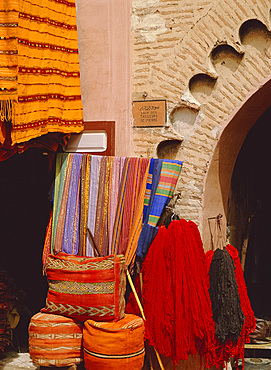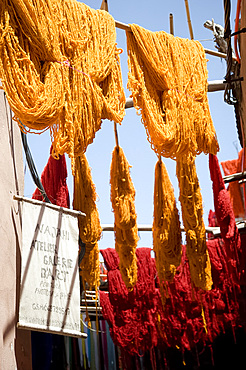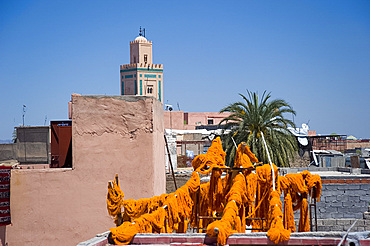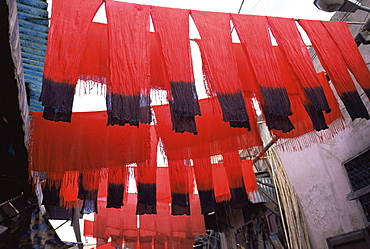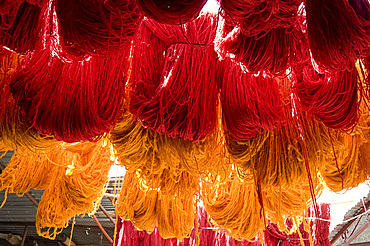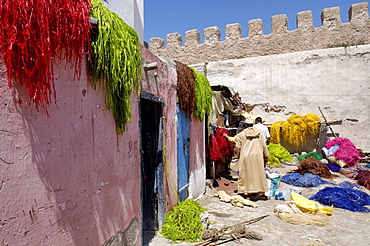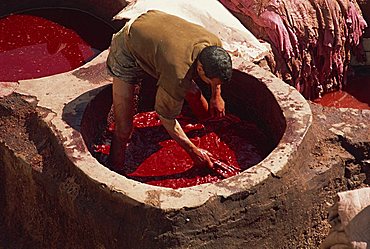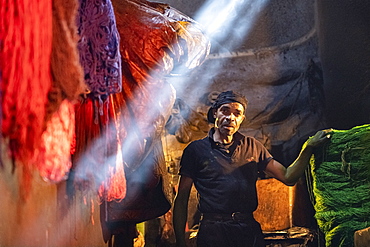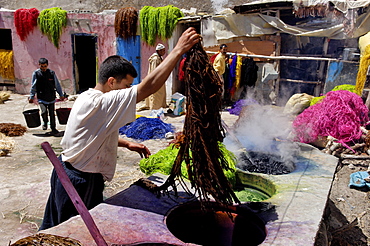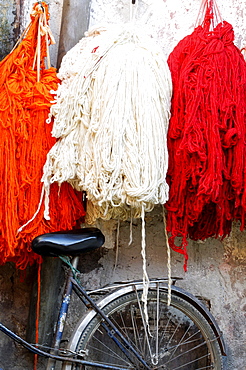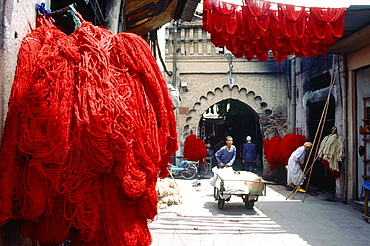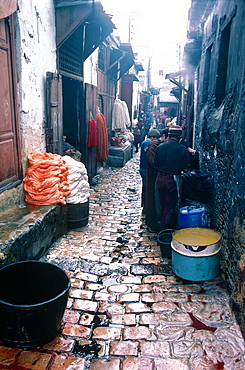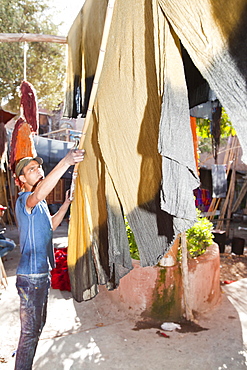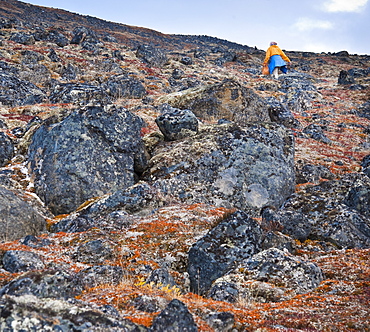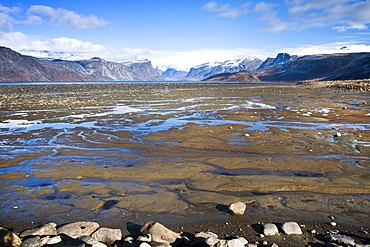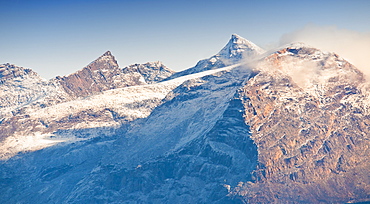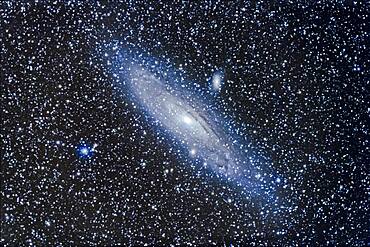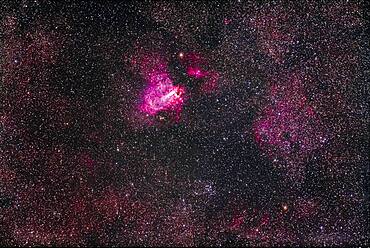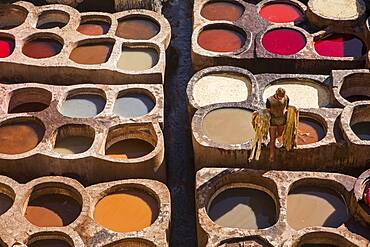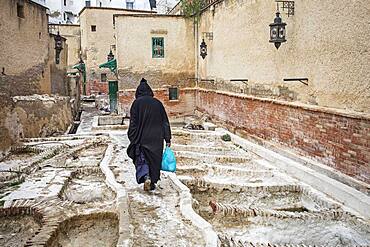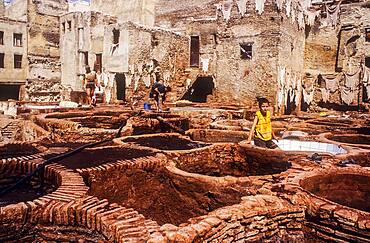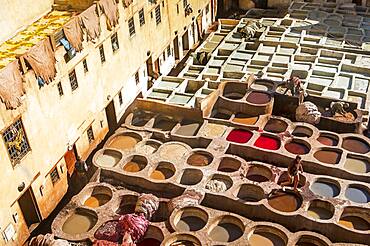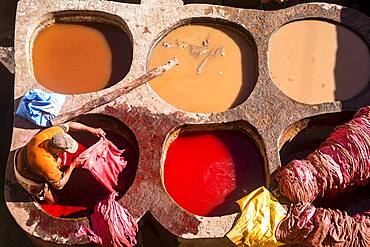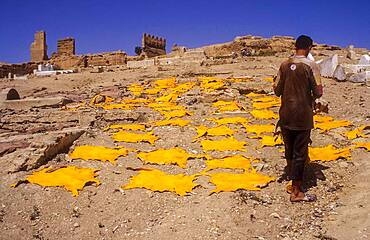Results
18 results found
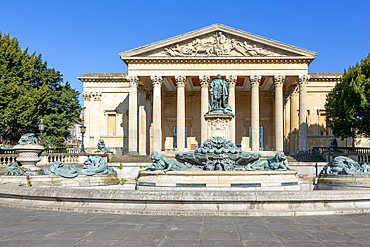
Victoria Rooms building, Clifton, Bristol, England, UK architect Charles Dyer 1842 Greek revival style
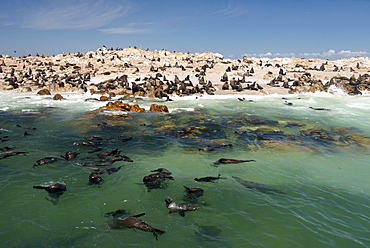
Cape fur seal colony (Arctocephalus pusillus) at Geyser Island, Dyer Island offshore from Klein baai, Western Cape, South Africa, Africa
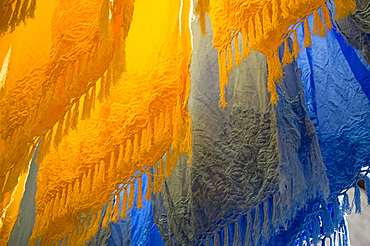
Brightly coloured dyed fabrics hanging to dry in the dyers souk, Marrakech, Morocco, North Africa, Africa
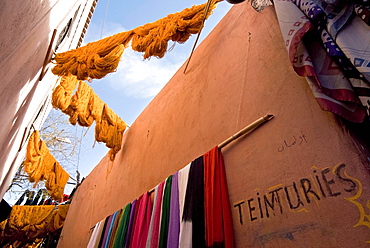
The Dyers Souks, freshly dyed wools drying, Medina, Marrakech (Marrakesh), Morocco, North Africa, Africa
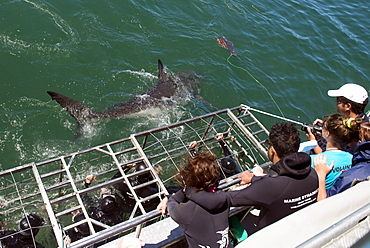
Great white shark swims by cage, great white shark cage diving, Marine Dynamics, Dyer Island, South Africa, Africa
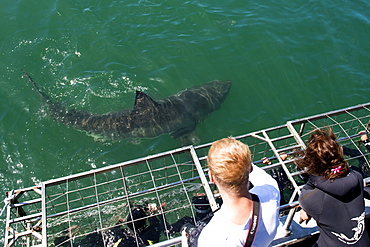
Great white shark swims by cage, great white shark cage diving, Marine Dynamics, Dyer Island, South Africa, Africa

Musician Daniel Payne playing fiddle on mountain side. Pangnirtung, Cape Dyer, Baffin Island, Canada, North America
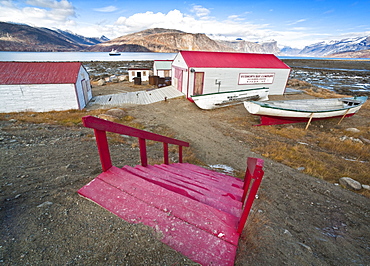
Remnants of the Hudson Bay Trading Company and Town views of Pangnirtung. Cape Dyer, Baffin Island, Canada, North America
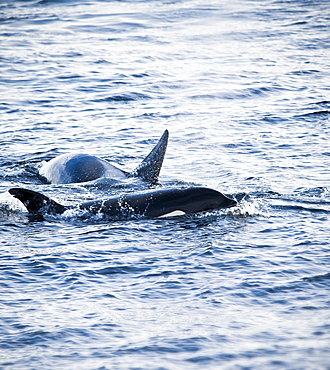
2 Orca (Orcinus orca), Killer whale, head above water. Cape Dyer, Baffin Island, Canada, North America

Circumpolar star trails over a grand old barn in southern Alberta, on a fine spring night, May 23, 2018. Illumination is from the waxing gibbous Moon to the south. This is looking north to Polaris at top right. A thunderstorm is on the northern horizon with a lightning bolt as a bonus.

Mars (at left) and the galactic centre area of the summer Milky Way low over the southern horizon at Writing-on-Stone Provincial Park, Alberta, on June 8/9, 2018. Sagittarus is at centre, with Scorpius at right. The Messier 6 and 7 open star clusters are just above the horizon at centre, just right of the Sweetgrass Hills on the horizon in Montana.

The Belt of Orion with the Horsehead Nebula at botton, the dark nebula set in the bright emission nebula IC 434. The nebula at left of the Zeta Orionis (aka Alnitak) is the Flame Nebula, NGC 2024. The reflection nebula at upper left is the M78 complex with NGC 2071. The other Belt stars are Alnilan (centre) and Mintaka (upper right). The field contains a wealth of other blue reflection and red emission nebulas.

The summer Milky Way overhead and through the Summer Triangle stars in July, looking up through trees in Banff National Park at Herbert Lake. Deneb is at top left, Vega at top right, and Altair is at bottom. The bright Cygnus star cloud is obvious. As are the dark lanes in the Milky Way, including the Funnel Nebula at top, aka Le Gentil 3.
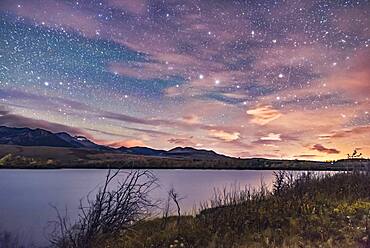
The Big Dipper in hazy clouds over the Waterton River at Maskinonge Pond, September 23, 2016, taken at the Night Photography Workshop I conducted there that night. The glow at right is light pollution from the Shell Waterton Gas Plant and from Pincher Creek to the north.
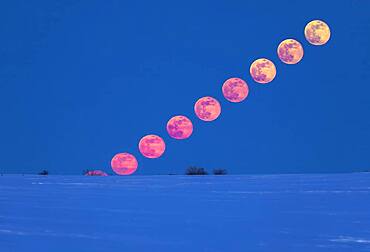
The rising of the Full Moon on Easter eve, Saturday, March 31, 2018, on a very cold night with lots of snow still on the ground in Alberta. So this is more a winter Moon than a spring one. This is the 'paschal' Moon ' the one that defines the date of Easter, being the first Full Moon after the vernal equinox. The first Sunday after that Full Moon, in this case the next day, is Easter Sunday.
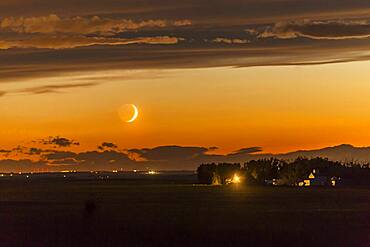
The waxing crescent Moon setting over a nearby farm, on June 26, 2017. Shot at the start of a time-lapse sequence, and shot in haste from home as the Moon appeared from beneath an otherwise very cloudy sky. The dark side of the Moon is lit by Earthshine, prominent despite the Moon's low altitude and bright twilight sky.
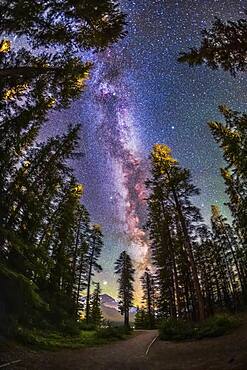
The summer Milky Way with the Summer Triangle stars through pine trees, shot from the Howse Pass Viewpoint at Saskatchewan River Crossing, Banff National Park, Alberta. Jupiter is the bright object at the bottom.

A horizon-to-zenith panorama of the winter consellations on a March evening as they set into the southwest. Orion is at bottom centre, with his Belt pointing down to Canis Major and up to Taurus. Gemini and Auriga are at top, in this case near the zenith overhead. The bright star clusters, M44, the Beehive, (at left) and M45, the Pleiades, (at right) flank the Milky Way. M45 is embedded in the Zodiacal Light. The star clusters M35 in Gemini and M41 in Canis Major are also visible as diffuse spots, as are several other star clusters. A couple of satellite trails are visible.

Here's a variation on creating a time-sequence composite of the August 21, 2017 total solar eclipse.
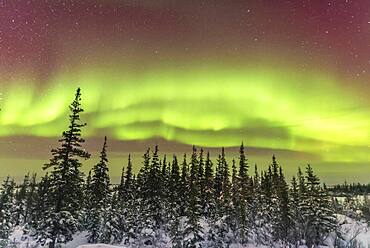
An aurora over the snowy boreal forest trees at the Chruchill Northern Studies Centre, Churchill, Manitoba, March 3, 2016. The display started the night quite impressively but then faded and subsided. This is a 10-second exposure a f/2 and ISO 3200 with the Nikon D750 and Sigma 20mm Art lens.
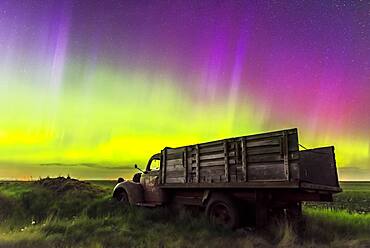
An aurora display on the night of June 7/8, 2015 from southern Alberta, with an old rustic farm truck as the foreground. This is a frame from a 450-frame time-lapse with the Nikon D750 at ISO 1600 and the Sigma 24mm lens at f/2.8, for 8 seconds each. The foreground is from a stack of 8 images adjacent in time to the sky image stacked in Mean mode for smoothing of noise.
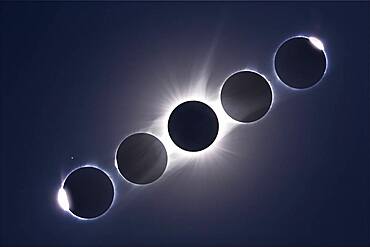
A composite of the August 21, 2017 total eclipse of the Sun, showing the second and third contact diamond rings and Baily's Beads at the start (left) and end (right) of totality, flanking a composite image of totality itself. The diamond ring and Baily's Beads images are single images.

The Milky Way arching over Emerald Lake and Emerald Lake Lodge in Yoho National Park, BC. This was on June 6, 2016 and despite it being about 1:30 am, the sky, especially to the north at left, is still lit by blue twilight from the short solstice night.

The centre of the galaxy area of the Milky Way toward Sagittarius and Scorpius, with the Sagittarius Starcloud right of centre, and the Lagoon Nebula (M8) left of centre. The Cat's Paw Nebula (NGC 6334) in Scorpius is at upper right, the Swan Nebula (M17) and Eagle Nebula (M16) are at lower left. To the right of them is the Small Sagittarius Starcloud (M24). At the very top is the Snake Nebula (B72). The main mass of dark nebula is the Pipe Nebula (B78). Above M24 at left is the open cluster M23 while below the M24 star cloud is the cluster M25. The globular M22 is at the bottom edge. At right of frame are the open clusters M6 (in the dark area of the Milky Way) and M7 (in the bright starcloud).
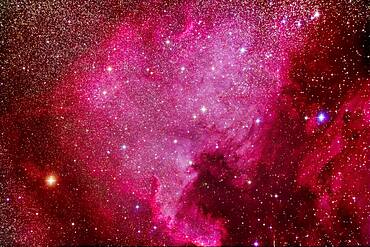
NGC 7000, the North America Nebula, with the Pelican Nebula, IC 5067, at right, in Cygnus, taken from home November 21, 2016 as part of testing of the Explore Scientific FCD100 102mm apo refractor. This is a stack of 5 x 6-minute exposures at f/7 with the ES field flattener, and at ISO 1600 with the filter-modified Canon 5D MkII. Star diffraction spikes added with AstronomyTools actions.

The False Comet Cluster area of southern Scorpius, which includes the open cluster NGC 6231 and emission nebula IC 4628, and open cluster NGC 6242 at top. This is a superb binocular field.
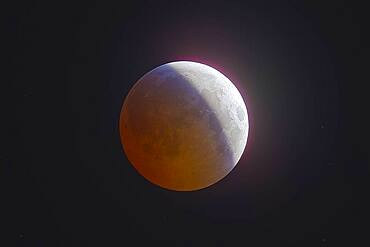
Total eclipse of the Moon, December 20/21, 2010, taken from home with 130mm AP apo refractor at f/6 and Canon 7D at ISO 400. An HDR composite of 9 images from 1/125 second to 2 seconds, composited in Photoshop CS5. Vibrancy increased to show bring out the colour variations across the shadow and at the edge of the shadow. Taken at about 12:21 am MST on Dec 21, about 20 minutes before totality began, during the partial phase.
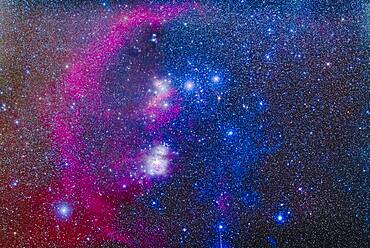
A mosaic of the Sword and Belt region of Orion the Hunter, showing the diverse array of colourful nebulas in the area, including: curving Barnard's Loop, the Horsehead Nebula below the left star of the Belt, Alnitak, and the Orion Nebula itself as the bright region in the Sword.

The large emission nebula IC 1805 in Cassiopeia, aka the Heart Nebula. The round nebula at top right is NGC 896. The large loose star cluster at centre is Mel 15; the star cluster at left is NGC 1027. The small cluster below NGC 896 is Tombaugh 4.
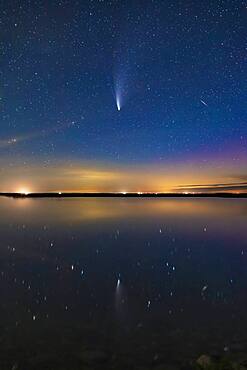
Comet NEOWISE (C/2020 F3) reflected in the still waters this night of Crawling Lake in southern Alberta. A dim aurora at right colours the sky magenta. Lingering twilight colours the sky blue. A meteor or more likely a flaring satellite appears at right and is also reflected in the water. Even in this short exposure, the two tails ' dust and ion ' are visible. This was July 20, 2020.
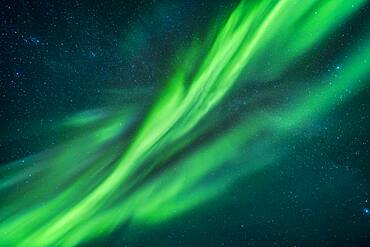
Auroral curtains at the zenith, with shades of green and cyan, from the display of September 8, 2018 taken from the Tibbitt Lake site near Yellowknife, NWT.
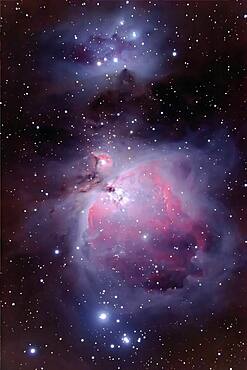
Orion Nebula region with NGC1973-7. Stack of two 10-minute exposures + stack of 30s and 1min exposure for retaining bright core deail. Blended with Normal @ 85% but erasing all of short exposure layer except for core.

All of Scorpius, plus parts of Lupus and Ara regions of the southern Milky Way. This area was directly overhead when I took this at about 4:30 am local time on April 6, 2014 from near Coonabarabran, Australia. The head of Scorpius is at top his tail at bottom though you could turn this image any direction and it would be correct as seen in the sky at this latitude, depending on the time of night. But in portrait mode like this north is at top. Along the Milky Way are numerous nebulas, including the False Comet area, the Cat's Paw area, and the colourful nebulas around Antares at top. The dark Pipe Nebula is at left of frame.

A mosaic of the region around the centre of the Milky Way in Sagittarius and Scorpius. The field takes in the Milky Way from the Cat's Paw Nebula at bottom edge to the Eagle Nebula at top left. In between from top to bottom are the Swan Nebula (M17), the Small Sagittarius Starcloud (M24), the Trifid and Lagoon Nebulas (M20 and M8) and the open clusters M6 and M7. The prominent dark nebula at right is the large Pipe Nebula (B78) with the small Snake Nebula (B72) above it. The whole complex is visible to the naked eye as the Dark Horse.

The complex area of clusters and nebulosity in central Auriga, including: M38 the Starfish Cluster and its smaller companion cluster NGC 1907; the emission/reflection nebulas NGC 1931, IC 417, IC 410 and IC 405 (from right to left here). Magenta and cyan (from emission and reflection components) IC 405 at right is the Flaming Star Nebula. Between IC 405 and IC 410 is the asterism known as The Little Fish.
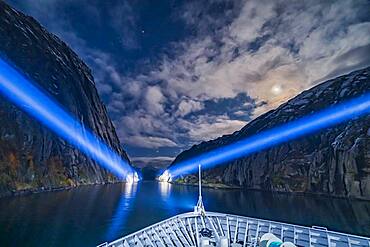
Exiting the narrow Trollfjord by searchlight and under moonlight, on the northbound voyage of the Hurtigruten ferry ship the ms Trollfjord, on October 15, 2019. Capella is at top; Betelgeuse and Orion are rising at centre at the mouth of the fjord; Aldebaran is partly in cloud left of the Moon.

The constellation of Scorpius with bright reddish Antares at top, with even brighter reddish Mars above it, and whie Saturn to the left of Antares. This shows all of Scorpius with Corona Australis and Ara below.
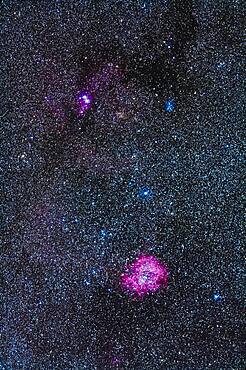
The area of the Rosette Nebula (bottom) and Christmas Tree Cluster (top) in Monoceros with the Fornax Lightrack tracker and 200mm lens + Canon 5D MkII. The nebulosity at top includes the Cone Nebula.
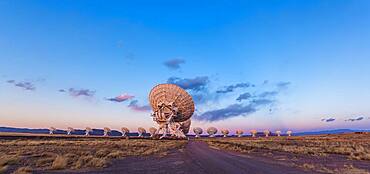
The Very Large Array (VLA) radio telescope in New Mexico, at sunset, March 17, 2013, with the Earth shadow rising at right and the pink Belt of Venus along the eastern horizon. This is a 2-section panorama, hand-held, with the 14mm lens and Canon 60Da camera.

The waning gibbous Moon approaches the star Aldebaran at an occultation on the morning of September 12, 2017. This is a multiple exposure composite of the ingress phase that occurred before sunrise, with the Moon from the final exposure and the star from exposures taken at 4-minute intervals prior to that last exposure. For the actual ingress I switched to HD movie to shoot a video of the event.
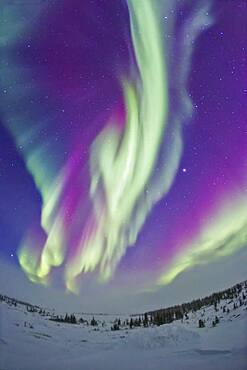
The Northern Lights on Feb 16, 2015, as seen from the Churchill Northern Studies Centre, in Churchill, Manitoba at 58° latitude, and under the auroral oval. The aurora appeared as skies cleared somewhat during a blizzard with high winds and blowing snow conditions. I shot these from the second floor deck of the Centre, out of the wind and off the ground. Jupiter is at right, the Big Dipper at left.
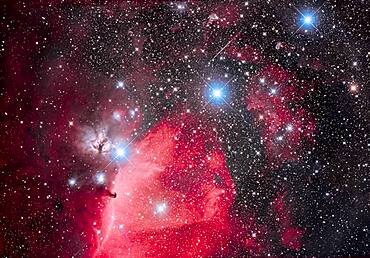
This is the Belt of Orion with its three blue stars across the top of the frame (L to R: Alnitak, Alnilam, and Mintaka), with the iconic Horsehead Nebula (aka B33) below Alnitak, with the dark Horsehead set against the bright nebula IC 434, aka Orion's Dagger. The pinkish nebula above Alnitak is NGC 2024, the Flame Nebula. The small blue reflection nebula left of the Horsehead is NGC 2023, with smaller IC 435 to the left of it. The field is filled with the large open cluster Collinder 70. The multiple star at bottom left of centre is Sigma Orionis. Many other smaller bits of reflection nebulas populate the field in and around the Belt.
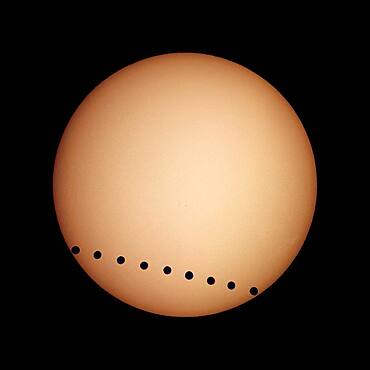
Transit of Venus, June 8, 2004, from Luxor, Egypt. A composite image (layered in Photoshop) of individual multiple shots taken from just after 2nd contact to just before 3rd contact. Taken with a Sony DSC-V1 digital camera shooting afocally through a 40mm eyepiece and on a 90mm apochromatic refractor, equatorially mounted and driven. Shot thru a Baader solar filter, which gives a white Sun. Yellow coloration added in Photoshop.
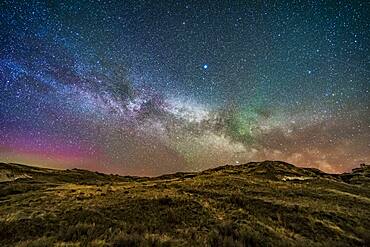
The summer Milky Way and Summer Triangle stars rising in the east at Dinosaur Provincial Park, Alberta on May 14, 2018.
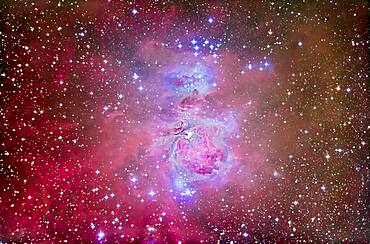
The Orion Nebula, M42 and M43, with surrounding associated nebula and star clusters, such as the Running Man Nebula above (NGC 1975) and blue star cluster above it, NGC 1981.
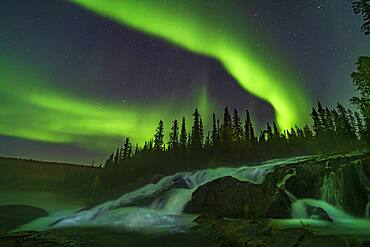
Curtains of aurora over the Ramparts falls on the Cameron River near Yellowknife, NWT, on Sept 8, 2019.
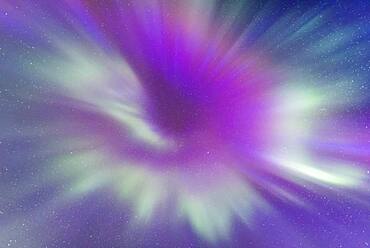
Auroral curtains converge at the zenith in the evening twilight during a Kp Index 7 night of aurora in Churchill, Manitoba. Blue twilight adds the blue tints to the sky and curtains.
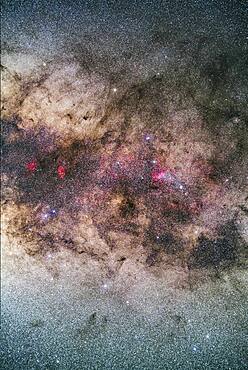
The tail of Scorpius, photographed with it high in the sky from Australia. The frame is oriented with the Milky Way running horizontally and the hook of the tail vertically.
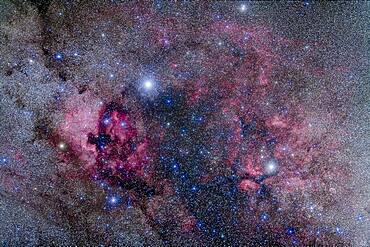
Nebulosity in the heart of Cygnus the Swan, including the North America Nebula and Pelican Nebula at left (NGC 7000 and IC 5070) and Gamma Cygni complex at right (IC 1318). The Crescent Nebula (NGC 6888) is at lower right. This is a stack of 5 x 4 minute exposures at f/2 with the 135mm lens and modified Canon 5D MkII at ISO 800, plus another three similar exposure images but taken thru the Kenko Softon filter for the star glows. Taken from home Sept 10, 2013.
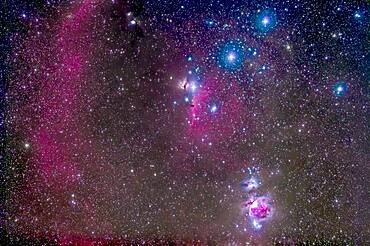
The Belt and Sword region of Orion, with the Orion Nebula, Messiesr 42 and 43, at bottom. Below the left star of the Belt, Alnitak, is the famous Horsehead Nebula, while above it is NGC 2024, aka the Flame Nebula. At very top left is Messier 78, while part of Barnard's Loop arc across the field at left. The field is filled with other faint red emission and blue reflection nebulas. The large loose open cluster Collinder 70 surrounds the middle star of the Belt, Alnilam.
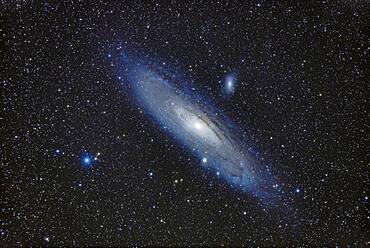
A demo image with the Orion 80mm CF Apo and Celestron AVX mount, with 3 x 8 minute and 3 x 6 minutes, at ISO 1600 with Canon 6D MkII plus shorter 3 x 2 minute and 3 x 1 minute exposures blended in with luminosity masks. Guided with the Orion Starshoot and Orion finderscope, using PHD2, with a lot of wild excursions in the guiding.

The spectacular field of Messier 8 and 20 emission and reflection nebulas in Sagittarius, with M8, aka the Lagoon Nebula below, and M20, the Trifid Nebula, above, all set in the rich starfields of the Milky Way. The diffuse nebula left of M8 is NGC 6559. Two globular clusters, NGC 6544 and NGC 6553, sit below and to the left (east) of M8. The Messier open cluster, M21, sits above M20.

Comet NEOWISE (C/2020 F3) over some of the eroded hoodoo formations at Dinosaur Provincial Park, Alberta, July 14-15, 2020. A faint aurora is at right. The foreground is lit by starlight only; there was no light painting employed here.
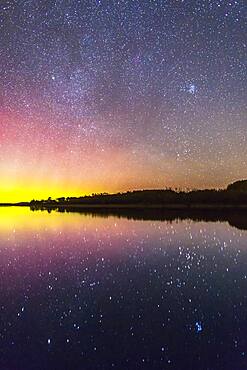
The rising autumn stars and constellations over and reflected in the lake at Police Outpost Provincial Park, in southern Alberta, on September 26, 2016. The stars of Auriga and Taurus are rising, including the Pleiades at upper right. Capella is the bright star above right centre; Aldebaran is below right in the sky. Both are reflected in the still water, along with the Hyades and Pleiades star clusters. A mild aurora is at left.
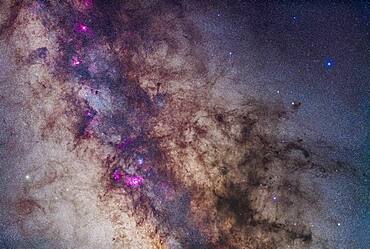
A mosaic of the region around the Small Sagittarius Starcloud and Dark Horse dark nebula complex. The field takes in the Milky Way from the Lagoon Nebula at bottom to the Eagle Nebula at top left. In between from top to bottom are the Swan Nebula (M17), and the Small Sagittarius Starcloud (M24). Flanking the bright M24 starcloud are the large open clusters M23 (right) and M25 (left). At bottom left is the M22 globular star cluster. The prominent dark nebula at right is the large Pipe Nebula (B78) with the small Snake Nebula (B72) above it. The whole complex is visible to the naked eye as the Dark Horse.

A flower-filled meadow at the Hay Barn Road at Waterton Lakes National Park, Alberta, with the summer Milky Way and Mars to the south over Waterton Valley and Vimy Peak at left.
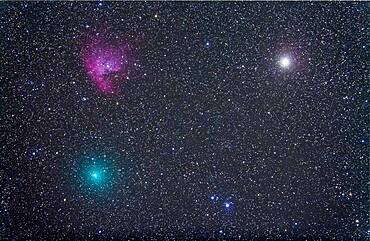
Comet Hartley 2 near the Pacman Nebula, NGC 281, in Cassiopeia. Stack of 4 x 6 minute exposures at ISO 1600 with Canon 5D MkII on A&M 105mm apo refractor at f/4.8 with Borg reducer/flattener. Bright star is Alpha Cas, Schedar. Autoguided with Celestron NexGuide autoguider. However, image of comet core is from only one exposure to minimize trailing from this fast-moving comet.

The Sun setting into a pall of forest fire smoke over Alberta from fires in B.C. and elsewhere, on August 17, 2018. This shows the dimming and reddening of the Sun as it set, with it disappearing from view long before it reached the horizon.

The eroding formations of Dinosaur Provincial Park, Alberta, lit by the rising gibbous Moon, off camera at right, on April 21/22, 2019. This is looking north, with the stars of the northern sky pivoting around Polaris.
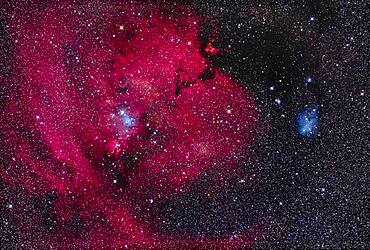
This is the nebula rich region in the constellation of Monoceros the Unicorn with the dark Cone Nebula (left of centre) and the small V-shaped and bright Hubble's Variable Nebula at bottom, a reflection nebula that varies in form and brightness. Above the Cone Nebula is the triangular Christmas Tree Cluster, NGC 2264, here upside down as the bright blue star 15 Mon is the base of the tree. The large region of nebulosity is Sharpless 2-273. The V-shaped dark nebula above centre is LDN 1603.
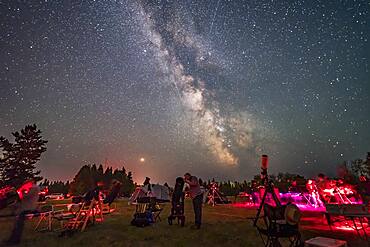
An observer gazes skyward with his Dobsonian reflector telescope at the Saskatchewan Summer Star Party on August 9, 2018, in the Cypress Hills of southwest Saskatchewan, at the Cypress Hills Interprovincial Park, a Dark Sky Preserve. The Milky Way shines to the south. Smoke in the sky obscures the horizon somewhat.
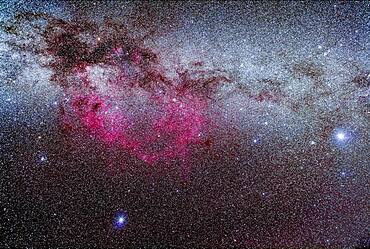
The region of the Milky Way in Puppis and Vela encompassing the vast Gum Nebula, a photographic object only. Sirius and Canis Major are at right; Canopus in Carina is at bottom. The False Cross and the open cluster NGC 2516 are at left.

A composite of the November 11, 2019 Transit of Mercury across the disk of the Sun, on a day with no sunspots on the Sun. The temperature was about -20�8 C to -15�8 C this morning but the sky was perfectly clear.

Photographer Stephen Bedingfield is shooting the Northern Lights at the Ramparts waterfalls on the Cameron River, September 8, 2019.

Astronomer Vance Petriew at the eyepiece of his 20-inch Dobsonian reflector telescope, at the 2012 Saskatchewan Summer Star Party in Cypress Hills, SK. This is a single 20 second exposure with the Canon 5DMkII at ISO 4000, and 24mm Canon L-series lens at f/2. A faint aurora adds the horizon colours. The photo was taken on the occasion of the second return of Comet Petriew 185/P since its discovery 11 years earlier in 2001 at this very same location.

